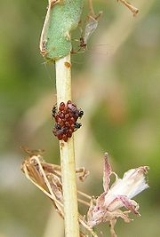
Scelionidae
Encyclopedia
The Hymenoptera
n family Scelionidae is a very large cosmopolitan group (over 3000 described species in some 160 genera) of exclusively parasitoid
wasps, mostly small (0.5-10 mm), often black, often highly sculptured, with (typically) elbowed antennae that have an 9- or 10-segmented flagellum
. Nowadays it is considered to be a subfamily of Platygastridae
.
They are generally idiobionts, attacking the eggs of many different types of insect
s or spider
s, and many are important in biological control. Several genera are wingless, and a few attack aquatic insect
eggs underwater.
Hymenoptera
Hymenoptera is one of the largest orders of insects, comprising the sawflies, wasps, bees and ants. There are over 130,000 recognized species, with many more remaining to be described. The name refers to the heavy wings of the insects, and is derived from the Ancient Greek ὑμήν : membrane and...
n family Scelionidae is a very large cosmopolitan group (over 3000 described species in some 160 genera) of exclusively parasitoid
Parasitoid
A parasitoid is an organism that spends a significant portion of its life history attached to or within a single host organism in a relationship that is in essence parasitic; unlike a true parasite, however, it ultimately sterilises or kills, and sometimes consumes, the host...
wasps, mostly small (0.5-10 mm), often black, often highly sculptured, with (typically) elbowed antennae that have an 9- or 10-segmented flagellum
Antenna (biology)
Antennae in biology have historically been paired appendages used for sensing in arthropods. More recently, the term has also been applied to cilium structures present in most cell types of eukaryotes....
. Nowadays it is considered to be a subfamily of Platygastridae
Platygastridae
The Hymenopteran family Platygastridae is a large group of exclusively parasitoid wasps, mostly very small , black, and shining, with elbowed antennae that have an 8-segmented flagellum...
.
They are generally idiobionts, attacking the eggs of many different types of insect
Insect
Insects are a class of living creatures within the arthropods that have a chitinous exoskeleton, a three-part body , three pairs of jointed legs, compound eyes, and two antennae...
s or spider
Spider
Spiders are air-breathing arthropods that have eight legs, and chelicerae with fangs that inject venom. They are the largest order of arachnids and rank seventh in total species diversity among all other groups of organisms...
s, and many are important in biological control. Several genera are wingless, and a few attack aquatic insect
Aquatic insects
Aquatic insects live some portion of their life cycle in the water. They feed in the same ways as other insects. Some diving insects, such as predatory diving beetles, can hunt for food underwater where land-living insects cannot compete.-Breathing:...
eggs underwater.
External links
- Cedar Creek Pinned specimen images.
- http://128.146.250.117/pdfs/20289/20289.pdf Paper on the The Genus Thoron.

